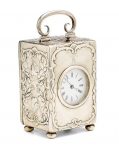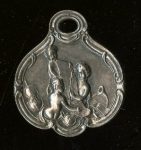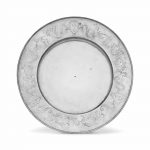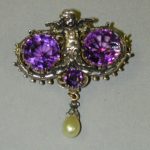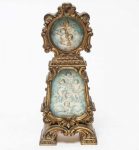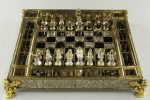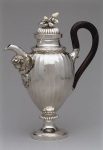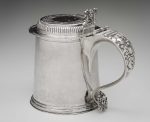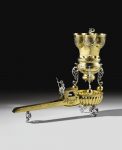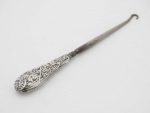Cherubs have held a mystical fascination throughout time. One of the most famous cherubs is Cupid, who was the Roman God of Love. He was also known as Amor and in Greek Mythology he was known as Eros. There are many different stories of Cupid. To some he is the Son of Venus, the Goddess of Love and Mars the God of War. To others he is the son of Mercury and Aphrodite. He is sometimes depicted as been hatched from a silver egg. It is therefore not surprising that Cupid or his messengers are often incorporated into the design of many silver items.
Cupid is renowned for carrying his bows and arrows, and those who are hit by the arrows are forseen to fall in love with the next person they see. The Romans and the Greeks often had conflicting ideas about him. It was the Romans who knew him as Cupid and regarded him as a symbol of life after death whereas the Greeks were aware of his beauty .
To some cherubs are often known as descendents of Cupid but they are also an important feature in the Tanakh or Hebrew Bible.
In art, Cherubs are often confused with Putti. These are innocents which look like winged children and were famous in both Italian Renaissance Art and Rococo Art.
An Edwardian repousse silver repeating carriage clock The case by William Comyns, London, 1901 The case with loop handle, top and sided repousse with winged cherub heads within a border of foliate scrolls and clouds, circular white enamel dial with roman chapters, blued Breguet hands, gilt two train movement with gilt platform lever escapement, striking the hour and half hour and repeating the hour on a gong. 7 ½ in (19 cm) high
Sold for US$ 2,500 (£ 1,961) inc. premium at Bonhams in 2018
Medallion; shaped; silver; suspension loop; obverse: relief of three cupids playing instruments; scrollwork border; reverse: engraved number; inscribed
Reference: © The Trustees of the British Museum
Silver teakettle on stand with burner, elaborately decorated with repoussé, incised, and cast decorations. (a) Teakettle has pear-shaped body with hinged lid; raised on four feet composed of cast naturalistic flowers and leaves; attached S-shaped spout; and hinged handle that arches over top of lid. Body sectioned into several registers bordered by foliate and floral decorations; registers contain vignettes with a figure sitting under a tree, including an Chinese man holding a bird, a woman holding a fan, a man holding an umbrella, and a woman playing a guitar. (The center register on both front and back sides of kettle is blank, presumably for inscriptions.) The neck of the kettle and the lid are fluted and incised foliate decorations; finial of lid is formed of cast flowers and leaves. Spout is textured to resemble bark and is covered with applied flowers, vines, and leaves. Hinge plates for handle consist of head of a bearded man. Handle is bowed out at sides and covered with foliate and scroll forms; two ivory bands around grip. (b) Stand: ring with angled sides raised on four S-shaped legs, each decorated with head of a cherub at the top, shells, and a flat palmette foot; cast garlands of flowers hang between the legs. Within the stand is a simple frame for holding the oil burner. Teakettle sits on ring and can be fastened to the stand with two pins that are chained to the base. (c) Bowl shaped burner with straight sides and slightly domed cover; wick in center.
Reference: The Brooklyn Museum
THE DIAMOND-NEWMARCH-MUGRIDGE PLATTER: A HIGHLY IMPORTANT ENGRAVED SILVER SERVING PLATE MARK OF JEREMIAH DUMMER, BOSTON, 1680-1700 Circular, with molded border, the wide rim finely engraved with three stylized cherub’s masks between a meandering leafy vine with tulips, sunflowers, and a carnation, the reverse engraved with original monogram D over AI, marked on rim with Kane mark A 11 3/8 in. (28.8 cm.) diameter; 17 oz. (531 gr.)
Sold for USD 149,000 at Christies in 2016
Antique Amethyst Pin The silver pin designed as a cherub resting on a small round amethyst, flanked on each side by a larger round amethyst, additionally enhanced by small rose-cut diamonds and suspending an imitation pearl drop, some stones missing. Length 2 3/4 inches.
Sold for $375 (includes buyer’s premium) at Doyle New York in 2001
Portuguese sterling silver-gilt vermeil Rococo miniature enamel putti / winged cherubs and clouds, table / desk clock in the Viennese manner, marked with the early eagle sterling assay mark and maker’s mark, “…rira Marques …rto Lisboa,” circa 1900. 6.25″ H x 2.675″ W x 1.5″ D. Approx 17.76 ozt inclusive.
Sold for $650 at Auctions at Showplace in 2019
A chess set of crystal, quartz, and silver The board is composed of thirty-two squares of rock crystal alternating with thirty-two squares of smoked quartz, all cased in silver. Each square of rock crystal is backed with a silver foil bearing a silver flower with red enamel petals and green enamel leaves. Similarly, each square of quartz is backed with a black foil adorned with a gilt silver flower with leaves of silver. These flowers are thus visible through the opaque squares. Half of the pieces, which are not all original, are carved from rock crystal (the white pieces), and the other half (the black pieces) from smoked quartz. Each piece is six-sided, carved from a single block and mounted in gilt silver.
In 1791 the sides of the board were still embellished with gilt copper on a ground of blue enamel. Now the sides are plated with a stamped silver frieze of foliage added in the nineteenth century. The corners rest on the heads of chubby winged cherubs in gilt bronze dating from the seventeenth century. Added in the eighteenth century, these may be of Italian workmanship. Royal inventories often listed chess sets made of semi-precious stones. The presence of the little boxwood figures links this set with others listed in inventories as belonging to the Palais du Louvre. This set was listed in the inventory of the collections of Gabrielle d’Estrées (1573-99), and later in the gem collection of Louis XIV under number 31. As one piece was lost, Louis XVIII gave the set to his first valet de chambre, Thierry de Ville-d’Avray.
Reference:The Louvre
Hot milk pot. Maker: Alois Simpert Eschenlohr (1785–1837, master 1824) 1823–24
Early in the nineteenth century it became the custom to produce pots for coffee and hot milk en suite, and this piece was acquired together with its matching, smaller milk pot. Eschenlohr-who became a master silversmith in I824 has taken a simple Neoclassical form and enlivened it with a playful contrast of surface effects, decorative details, and materials. A cherub’s head emerges from a cluster of grapes beneath the spout, the cover is topped by a trio of ivory acorns, and the dark smoothness of the handle complements the light-catching fluting of the body.
Reference: The Metropolitan Museum of Art
Tankard about 1700 Henry Hurst (American, born in Sweden, 1666–1717)
Straight tapering sides, moulded base & rim; flat top with serrated edge, reeded shoulder and chased border. Scroll handle embossed with fruit and flowers, rat-tail drop, cherub’s head tip, reeded hinge, dolphin and mask purchase. In seventeenth- and eighteenth-century America, the tankard was defined as “a large vessel with a cover, for strong drink,” such as beer, ale, or hard cider. Silver examples varied greatly in size, from small tankards made for individual use to more capacious ones that held as many as four quarts to be passed from hand to hand around the table.
Reference: Museum of Fine Arts Boston
A rare German silver parcel-gilt Trinkspiel (drinking game) cup, Hans Maulbrunner, Augsburg, 1614-1616 on three shell-shaped feet with cherubs, the base shaped as a gadrooned cup engraved with bunches of fruit and garlands ending in a funnel, surmounted by a watermill with a Neptune-shaped finial, the upper six-cupola-shaped cup on three feet, engraved with birds and fruit 26,6 x 31, 2 cm, 10 2/3in. x 12 1/3in. ; 702 g., 24oz 76dwt
Inspired by the wedding feast at Cana (Gospel according to Saint John, 2,1-11), this drinking game is completed with an elaborate mechanism giving the perfect illusion of turning water into wine. During the 16th and 17th centuries, wine inspired goldsmiths to produce the most unusual objects, such as wedding cups, windmill and watermill beakers. They competed with each to create the most playful, unusual and ingenious pieces. Of all the types of drinking game cups created, of which the earliest pieces were mentioned at the beginning of the 16th century in the Netherlands and Germany, this type of trinkspiel was certainly the most elaborate version.
Sold for 218,750 EUR at Sothebys in 2018
Penknife with a parcel-gilt silver handle with a pommel of cherub’s heads and scrolls circa 1600
Reference: © Victoria and Albert Museum
